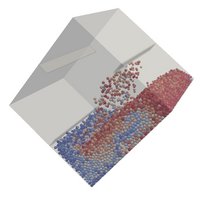Discretization Methods: Particle Methods
Particle methods are a very powerful tool when analyzing systems consisting of large numbers of rather simple physical objects. The motion and interation of particles need to be taken into account in order to describe even complex phenomenons. Considering contact between particles and contact of particles with possible boundaries, e.g. the behaviour of granular media can be described very well.
Many objects in nature can be assumed in good approximation as hard and spherical allowing the use of an easy description for each of the particles. Short-range forces such as contact forces can either be treated with methods well-known from the Discrete Element method (DEM) or from the Molecular Dynamics (MD). In the DEM penetration of particles is allowed and dense systems of particles can be simulated. Time step sizes are highly restricted when rapidly moving small particles are of interest in order to preserve stability. Dilute systems are more suitable for the MD treatment where penetration is not allowed and often only binary contact is considered.
Applications at the Institute for Computational Mechanics include stand-alone particle simulations or coupled problems where interaction of particles with other fields is of importance. Cavitation, a highly complex multi-phase phenomenon, is an example in which fluid interacts with submerged bubbles described as particles.
